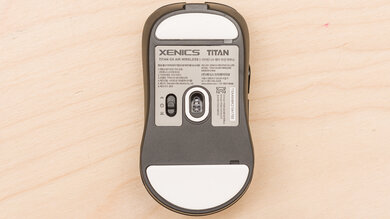The Xenics Titan GX AIR Wireless is an ambidextrous gaming mouse with two buttons on the left side and a pair of swappable palm rest segments. The first palm rest has honeycomb-shaped cutouts, while the second is a more traditional, solid plastic style. Its shape is very similar to the BenQ ZOWIE EC2 but slightly smaller. It's well-suited for all grip types and most hand sizes, but it's too small for small hands to use comfortably using any grip type. You can connect it wirelessly with its USB receiver or wired with its USB-C charging cable, and it has a compartment under the palm rest for storing the receiver when it's not in use. Performance-wise, it has a very low lift-off distance, and you can adjust the CPI by increments of 50 within a broad range. Unfortunately, it has high click latency, and you may prefer a more responsive-feeling option, especially if you play fast-paced or reaction-based games.
Our Verdict
The Xenics Titan GX AIR Wireless is very good for office and multimedia work. It connects wirelessly with its USB receiver or wired with its USB-C charging cable, and it has a comfortable, ambidextrous shape suitable for all grip types and most hand sizes. However, it isn't suitable for small hands using any grip type. Unfortunately, it doesn't have any Bluetooth connectivity options, and its scroll wheel doesn't have L/R tilt inputs or a free-scrolling mode.
-
Feels well-built.
-
Connects wirelessly with a USB receiver.
-
Ambidextrous shape suitable for all grip types.
-
Scroll wheel lacks a free-scrolling mode and L/R tilt buttons.
-
No Bluetooth connection option.
The Xenics Titan GX AIR Wireless is an impressive mouse for FPS gaming, but it has high click latency, and some gamers may prefer a more responsive-feeling option. That said, it feels well-built and is very lightweight, regardless of which palm rest you're using. Its ambidextrous shape is suitable for all grip types and all but small-sized hands. It also has mouse feet that glide very smoothly on mousepads and desks and a flexible paracord-like cable with a USB-C connector, making it easy to replace if it gets damaged. Performance-wise, it has a very low lift-off distance, and you can adjust the CPI by increments of 50 within a broad range.
-
Feels well-built.
-
Very lightweight.
-
Ambidextrous shape suitable for all grip types.
-
High click latency.
The Xenics Titan GX AIR Wireless is satisfactory for MMO gaming, but it doesn't have nearly as many side buttons as a dedicated MMO gaming mouse, and it has high click latency. Nevertheless, it feels well-built and has an ambidextrous shape suitable for all grip types and all except for small hands. Performance-wise it has a very low lift-off distance, and you can adjust the CPI by increments of 50 within a wide range. Unfortunately, it has high click latency for a gaming mouse. While you can set custom profiles using the software, there's no way to assign a button to cycle between them, meaning you need to manually swap them using the software.
-
Feels well-built.
-
Ambidextrous shape suitable for all grip types.
-
Not nearly as many side buttons as a dedicated MMO gaming mouse.
-
High click latency.
The Xenics Titan GX AIR Wireless is an impressive ultra-lightweight gaming mouse, but it has high click latency. Nevertheless, it's very lightweight regardless of which modular palm rest you install, and it feels very sturdy. Its ambidextrous shape is suitable for all grip types. However, it isn't suitable for small hands using any grip type. Its feet glide very smoothly on mousepads and desks, and its USB-C charging cable is flexible and feels high quality. It also has a very low lift-off distance, and you can adjust the CPI by increments of 50 within a broad range.
-
Feels well-built.
-
Very lightweight.
-
Ambidextrous shape suitable for all grip types.
-
High click latency.
The Xenics Titan GX AIR Wireless is great for travel, but it's somewhat bulky and may not fit in most laptop cases. That said, it connects wirelessly with its USB receiver and includes a compartment for the receiver under the palm rest for whenever it's not in use. It has onboard memory, so you can save custom settings to the mouse and use it with computers without installing the software. Unfortunately, it doesn't have Bluetooth support.
-
Feels well-built.
-
Connects wirelessly with a USB receiver.
-
Uses an easily-replaceable USB-C charging cable.
-
No Bluetooth connection option.
-
Bulky; may not fit in most laptop cases.
- 8.0 Office/Multimedia
- 8.1 Video Games (FPS)
- 7.3 Video Games (MMO)
- 8.3 Ultra-Light Gaming
- 8.0 Travel
Changelog
- Updated Sep 15, 2021: Review published.
- Updated Sep 08, 2021: Early access published.
- Updated Jul 05, 2021: Our testers have started testing this product.
- Updated Jun 23, 2021: The product has arrived in our lab, and our testers will start evaluating it soon.
- Updated May 09, 2021: We've purchased the product and are waiting for it to arrive in our lab.
Check Price
Differences Between Sizes And Variants
The Xenics Titan GX AIR Wireless we tested is black, and there are no other color variants. You can see the label for our unit here.
Compared To Other Mice
The Xenics Titan GX AIR Wireless is a very good wireless gaming mouse that's very similar to the Pwnage Ultra Custom Wireless Symm. Like the Pwnage, the Xenics also includes both a solid plastic and honeycomb-style palm rest. However, the Pwnage has additional honeycomb cutouts on the sides of the mouse, while the Xenics has solid plastic sides. Shape-wise, both mice are also clearly inspired by the BenQ ZOWIE EC2, but they're somewhat smaller. Overall, the Xenics Titan GX AIR Wireless is a great choice for fans of the EC2 shape looking for a lightweight, wireless alternative. Unfortunately, it has high click latency for a gaming mouse and may not feel responsive enough for all gamers.
For other recommendations, see our picks for the best lightweight mouse, the best wireless gaming mouse, and the best gaming mouse.
The Finalmouse Starlight-12 Medium is a better ultra-lightweight, wireless gaming mouse than the Xenics Titan GX AIR Wireless. The Finalmouse is much lighter and feels sturdier. It also has a more flexible charging cable and lower click latency. On the other hand, the Xenics has a much wider CPI range, and you can adjust the CPI by increments of 50, while you can only cycle between four CPI presets on the Finalmouse. The Xenics also has customization software and a storage compartment for its USB receiver, two features the Finalmouse lacks.
The Xenics Titan GX AIR Wireless is a better ultra-light gaming mouse than the DREVO Falcon Wireless RGB. The Xenics is much lighter, feels better built, and has smoother-gliding mouse feet. Also, it has a wider CPI range, a more adjustable CPI, and a lower lift-off distance. While both mice have fairly high click latencies, it's lower on the Xenics, especially when used wirelessly. Both mice are suitable for all grip types, but people with small hands may feel more comfortable with the DREVO for a palm or claw grip.
The GLORIOUS Model D and the Xenics Titan GX AIR Wireless are lightweight mice with comparable performance, but the GLORIOUS is a wired-only model, while the Xenics is wireless. The GLORIOUS is somewhat lighter and has a more flexible cable. It also has mouse feet that glide more smoothly and much lower click latency. On the other hand, the Xenics feels sturdier and has a wider CPI range. It also has a more precisely adjustable CPI and a lower lift-off distance. Both mice are suitable for all grip types and most hand sizes, though only the GLORIOUS is suitable for small hands using a palm grip.
The Razer DeathAdder V2 is an excellent wired gaming mouse, while the Xenics Titan GX AIR Wireless is a great, ultra-lightweight gaming mouse. The Razer is a wired-only model with two additional buttons, including a profile switch button on the underside. You can also set a HyperShift button to enable a secondary layer of commands. Performance-wise it has a slightly higher maximum CPI and much lower click latency. On the other hand, the Xenics connects either wirelessly with its USB receiver or wired with its USB-C charging cable. It's also somewhat lighter, it feels sturdier, and despite being a wireless mouse, its charging cable is more flexible.
The Razer Basilisk V2 is an excellent wired-only gaming mouse, while the Xenics Titan GX AIR Wireless is an impressive ultra-lightweight gaming mouse. The Razer has a thumb rest and five additional programmable buttons. You can also set a HyperShift button to enable a secondary layer of commands, and its scroll wheel has L/R tilt buttons and a free-scrolling mode. Performance-wise, it has a slightly higher maximum CPI, a more consistent sensor, and much lower click latency. On the other hand, the Xenics connects wirelessly with its USB receiver or wired with its USB-C charging cable. It's also much lighter and feels sturdier.
The Logitech G PRO X SUPERLIGHT is a better ultra-lightweight gaming mouse than the Xenics Titan GX AIR Wireless. The Logitech is significantly lighter and has mouse feet that glide more smoothly. It also has a higher maximum CPI, a more consistent sensor, and much lower click latency. You can also set a G-Shift button to enable a second layer of controls. Its software is compatible with Windows and macOS, while the Xenics software is only compatible with Windows. On the other hand, The Xenics has one additional programmable button. It also has a more flexible charging cable with a newer USB-C connector, making it much easier to replace if it gets damaged.
Test Results
There's a compartment under the palm rest for storing the USB receiver when it's not in use.
The solid plastic palm rest weighs approximately 2g more than the honeycomb palm rest. It's also possible to remove the palm rest piece and use the mouse without it. Doing so reduces the weight of the Xenics Titan GX AIR Wireless to 71.14g. If you're interested in a gaming mouse that's just as lightweight but also has a solid plastic shell, check out the SteelSeries Prime Mini Wireless. Or, for an even lighter option with a solid plastic shell, check out the Ninjutso Origin One X.
For a similar gaming mouse that has grippy, rubberized side grips, check out the MSI CLUTCH GM41 LIGHTWEIGHT WIRELESS.
The manufacturer's website claims the Xenics Titan GX AIR Wireless has a battery life of up to 70 hours. However, this isn't something we test. The LED lights on the Xenics Titan GX AIR Wireless flash when the battery reaches below 10%.
The polling rate options on the Xenics Titan GX AIR Wireless are 125Hz, 250Hz, 500Hz, and 1000Hz.
You can reprogram all the buttons on the Xenics Titan GX AIR Wireless, but you need to have one button assigned as a left-click button at all times, and you can't reprogram the up/down inputs of the scroll wheel. You can customize six CPI settings and cycle between them using the CPI button behind the scroll wheel by default. There's an off switch on the bottom of the Xenics Titan GX AIR Wireless that also toggles the LED lighting.
You can configure custom profiles and switch between them using the software. Unfortunately, you can't assign profile switching to a button, and there's no way to automatically switch profiles when launching certain games or apps.
Comments
Xenics Titan GX AIR Wireless: Main Discussion
Let us know why you want us to review the product here, or encourage others to vote for this product.































